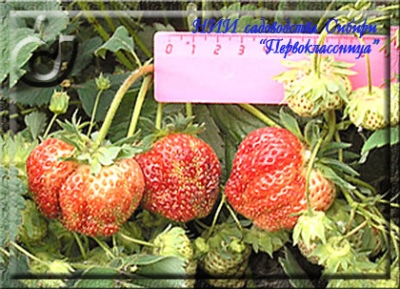
- Authors: A.D. Zabelina, N.P. Stolnikov, Lisavenko Research Institute of Horticulture of Siberia
- Taste: sweet and sour
- The size: average
- Weight: 10.1-38.1 gr
- Yield rate: high
- Yield: 13.5-23.7 t / ha
- Repairability: No
- Ripening terms: medium
- Appointment: universal
- Description of the bush: undersized, semi-spreading
The First Grader strawberry is very popular with gardeners. Thanks to the easy care and pickiness of the bushes, planting berries of this variety is recommended for growing even for novice gardeners.
Breeding history of the variety
This strawberry variety was bred and entered in the register in 2005. The view turned out thanks to the crossing of the Torpedo and Fairy varieties. Its development belongs to breeders N.P. Stolnikova and A.D. Zabelina - employees of the Lisavenko Research Institute of Horticulture in Siberia.
Description of the variety
The first grader does not belong to the remontant species, she easily takes root in the new area. Bushes are capable of fruiting both in a sunny area and in a shaded area.
The bush is undersized, semi-spreading. The foliage has a typical three-leafed appearance. The leaf is large, carved, green, highly shiny, with a characteristic waxy coating.
Ripening terms
This type of strawberry belongs to the mid-late varieties. The ripening time of the berries depends on the climatic zone in which the bushes are grown. In temperate climates, the first fruits begin to ripen in late May - early June. The fruiting period lasts about a month.
Growing regions
The Pervoklassnitsa variety was bred directly for cultivation in Western Siberia and the Urals. Thanks to breeders, the bushes of this strawberry grow well in open windy areas. They winter well even under a small layer of snow. When the soil is frozen, the root system and leaves quickly recover in spring.
Yield
The yield indicators of this type of strawberry are considered good. It can yield 13.5-23.7 t / ha.
Berries and their taste
Berries are medium in size. The weight of each is 10.1-38.1 g. At the beginning of fruiting, the berries are larger, weighing up to 30 g. By the end of the fruiting period, they become smaller, and the weight of the berry does not exceed 10 g.
The berries are bright red in color with a clearly visible sheen. The taste of the berries is sweet, there is a slight sourness. The pulp is juicy, has a pronounced strawberry aroma.
Each berry contains 6.6% sugars, 1.3% acids, 41.8 mg / 100 g of ascorbic acid. According to experts, the tasting score of the fruit is quite high and amounts to 4.5 points out of 5 possible.
Growing features
The first grader belongs to varieties that do not require special care. The main task for obtaining a rich harvest is choosing the right place for its growth.




Site selection and soil preparation
To get the maximum yield of strawberries of this variety, you need to take care of the place of its future growth and prepare it correctly:
you need to choose sunny or slightly shaded areas of the soil;
avoid for planting areas near fences;
do not plant bushes in places of stagnant water, under trees.
Preparing the soil for cultivation includes preliminary digging, loosening, applying ash and other organic fertilizers.

Pollination
The variety is self-pollinating. Special actions and manipulations for pollination of bushes are not required.
Top dressing
It is necessary to apply fertilizers to the soil during its preparation before planting bushes, as well as during the period of leaf regrowth. Fertilization should be stopped after the formation of ovaries. Organic fertilizers such as mullein or poultry manure infusion are great for fertilizing.
It is necessary to apply fertilizer under the bush, avoiding contact with the solution on the leaves and ovaries of the buds.

One of the important techniques in strawberry care is feeding. Regular fertilization guarantees a rich harvest. There are several different ways to feed strawberries, and each of them is designed for a specific period of plant development. During flowering, fruiting and after it, feeding should be different.
Frost resistance and the need for shelter
Since the first-grader strawberry is recommended for cultivation in Western Siberia, its frost resistance is high. The bushes can easily withstand frosts down to -30 degrees without special shelter. You need to take care of the covering material only in the case of a severe winter with little snow, when the snow cover does not reach a height of 5 cm.
In this case, the strawberry plantation can be covered with spruce branches or dry foliage.

Diseases and pests
The first grader is susceptible to pests and diseases such as:
powdery mildew;
white spot.
The likelihood of susceptibility to these diseases is not too high and reaches 1 point.

Strawberries are often subject to many dangerous diseases that can seriously undermine their condition. Among the most common are powdery mildew, gray mold, brown spot, anthracnose, and verticillosis. Before buying a variety, you need to inquire about its disease resistance.
Reproduction
It is possible to increase the plantation of a First-grader with the help of rosettes or mustaches that appear around the planted bushes in the second year of life.
In order to plant strawberries, the mustache should be carefully cut off from the main plant, then dig in without damaging the root system.
Strawberry variety First-grader is not prone to the formation of many shoots, therefore, in order to breed a plantation of berries, they will need to be planted over several seasons.
To make the berries larger, when planting bushes, you need to adhere to a distance of 50 cm from one bush to another. With this planting scheme, the bushes will be well ventilated, which will protect the berries from the formation of rot.



















































































